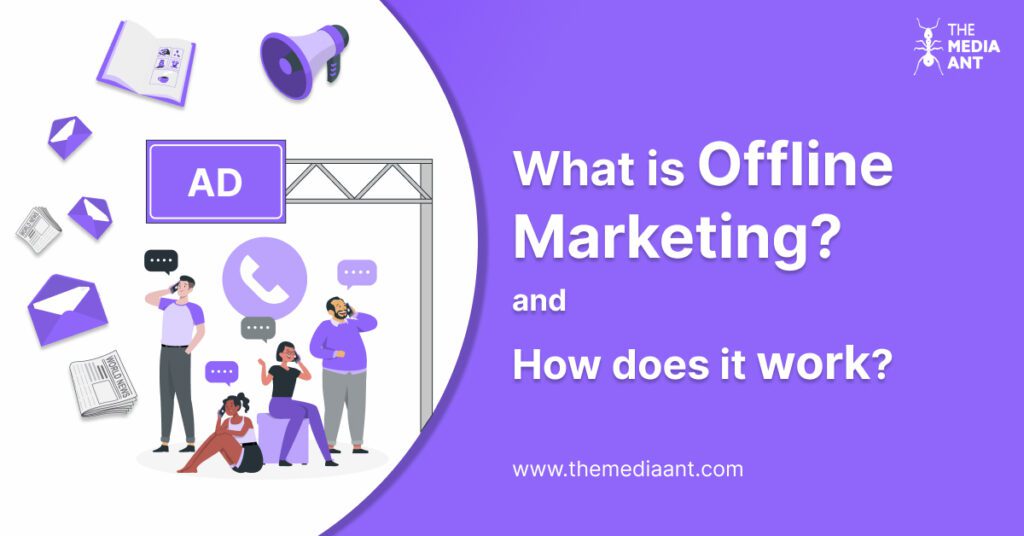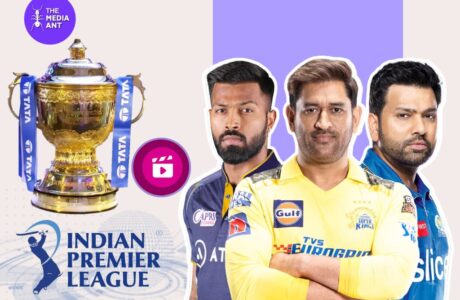Imagine a bustling city street adorned with eye-catching billboards, a local radio station broadcasting your favorite tunes, or a well-designed brochure that piques your curiosity at a coffee shop. These are just a few snapshots of the captivating world of offline marketing. In an era where we’re often glued to our screens, offline marketing remains a dynamic force that adds a tangible, human touch to brand promotion. But what exactly is offline marketing, and how does it weave its charm in an age of digital dominance?
In this blog, we’re embarking on an exciting journey to unravel the mysteries of offline marketing, exploring its strategies, benefits, and the remarkable impact it can have on your business.
So, let’s step away from our screens for a moment and venture into the world of real-life marketing, where face-to-face connections and tangible experiences reign supreme.
What is Offline Marketing?
Offline marketing is any type of marketing that is not done through the Internet. This includes a wide range of mediums and formats, from TV and radio commercials to billboards and print ads. Other examples of offline marketing include direct mail, public relations, and in-person events.
While online marketing has become increasingly popular in recent years, offline marketing still plays an important role in many businesses’ marketing strategies. Offline marketing can be effective for reaching a broad audience, building brand awareness, and generating leads and sales.
Benefits of Offline Marketing
Reach a broad audience: Offline marketing can reach a wide audience, including people who are not actively using the internet. This is especially important for businesses that target older demographics or people in rural areas.
Build brand awareness: Offline marketing can help to build brand awareness by getting your brand in front of people in a variety of settings. For example, seeing your ad on a billboard or in a magazine can help people to become more familiar with your brand.
Generate leads and sales: Offline marketing can also be effective for generating leads and sales. For example, a direct mail campaign can provide potential customers with more information about your products or services and encourage them to contact you.
Create a personal connection: Offline marketing can help to create a more personal connection with potential customers. For example, attending a trade show or industry event gives you the opportunity to meet potential customers face-to-face and learn more about their needs.
If you are considering using offline marketing in your marketing strategy, it is important to choose the right channels and formats for your target audience and budget. You should also track your results so that you can see which offline marketing campaigns are most effective for your business.
Why is offline marketing important?
Offline marketing is important for a number of reasons, including:
- It can reach a broad audience, including people who are not actively using the internet. This is especially important for businesses that target older demographics or people in rural areas.
- It can build brand awareness by getting your brand in front of people in a variety of settings. For example, seeing your ad on a billboard or in a magazine can help people to become more familiar with your brand.
- It can generate leads and sales. For example, a direct mail campaign can provide potential customers with more information about your products or services and encourage them to contact you.
- It can help to create a more personal connection with potential customers. For example, attending a trade show or industry event gives you the opportunity to meet potential customers face-to-face and learn more about their needs.
In addition to these benefits, offline marketing can also be more effective than online marketing in certain cases. For example, studies have shown that people are more likely to remember and respond to print ads than digital ads. Offline marketing can also be more effective for building trust and credibility with potential customers.
Overall, offline marketing is an important part of a well-rounded marketing strategy. It can help you reach a broader audience, build brand awareness, generate leads and sales, and create a more personal connection with potential customers.
Types of Offline Marketing
There are many different types of offline marketing, each with its own advantages and disadvantages. Some of the most common types of offline marketing include:
Direct mail: Direct mail is a great way to send targeted messages to potential customers. It can be used to promote new products or services, offer special discounts, or simply keep your brand in mind.
Print advertising: Print advertising includes ads in newspapers, magazines, and other print publications. It can be a good way to reach a large audience, especially in specific geographic areas.
Broadcast advertising: Broadcast advertising includes TV and radio commercials. It can be a very effective way to reach a large audience and build brand awareness, but it can also be expensive.
Outdoor advertising: Outdoor advertising includes billboards, bus bench ads, and other ads that are placed in public places. It can be a good way to reach people on the go and build brand awareness.
In-store promotions: In-store promotions include things like point-of-sale displays, coupons, and giveaways. They can be a good way to encourage customers to buy your products or services while they are already in your store.
Public relations: Public relations involves building relationships with the media and generating positive publicity for your brand. It can be a good way to build brand awareness and credibility.
Event marketing: Event marketing involves sponsoring or hosting events as a way to promote your brand and connect with potential customers. It can be a good way to build relationships and generate leads.
Offline Marketing Strategies
There are many ways for a brand to incorporate offline marketing into their advertising efforts. Here are 10 of the most effective strategies and ideas to consider for your next campaign.
Direct Mail: Believe it or not, direct mail still works wonders! Send personalized postcards or catalogs to your potential customers’ mailboxes. Make it irresistible with exclusive offers they can’t resist.
Community Engagement: Show your community some love! Sponsor local events, support a cause, or get involved in neighborhood activities. It’s not just good for your brand; it’s good for your soul!
Trade Shows: Trade shows aren’t just about free pens. They’re a chance to strut your stuff. Set up a booth, charm the crowd, and make those face-to-face connections that digital can’t replicate.
Promotion at Events: Host workshops, seminars, or talks related to your industry. It’s not about the hard sell; it’s about becoming the go-to expert in your field. People trust experts!
Press Releases: Got something newsworthy? Shout it from the rooftops! Send press releases to local media about your achievements, product launches, or community involvement. Get people talking.
Offering Product Samples: Sampling is the secret sauce! Let people taste or touch your product. Once they experience its awesomeness, they’ll be back for more.
Building a Business Network: Attend local business mixers, join chambers of commerce, or get involved in industry groups. Rub shoulders, make connections, and watch opportunities multiply.
Offering Discounts: Everyone loves a good deal. Spread the word about your discounts through flyers or brochures. Limited time only – act now!
Seasonal Cards: Don’t forget the power of a handwritten note. Send personalized holiday cards to your customers. It’s a classy way to say thanks and keep the connection alive.
Billboards: Be the star of the highway! Use billboards strategically placed in high-traffic areas. Get creative with your message – it’s the big stage for your brand!
Remember, these offline tactics can work wonders when paired with your online efforts. Mix and match to create a marketing symphony that resonates with your audience and leaves a lasting impression.
Offline Marketing Channels
Direct mail: Direct mail is a great way to send targeted messages to potential customers. It can be used to promote new products or services, offer special discounts, or simply keep your brand in mind.
Print advertising: Print advertising includes ads in newspapers, magazines, and other print publications. It can be a good way to reach a large audience, especially in specific geographic areas.
Broadcast advertising: Broadcast advertising includes TV and radio commercials. It can be a very effective way to reach a large audience and build brand awareness, but it can also be expensive.
Outdoor advertising: Outdoor advertising includes billboards, bus bench ads, and other ads that are placed in public places. It can be a good way to reach people on the go and build brand awareness.
In-store promotions: In-store promotions include things like point-of-sale displays, coupons, and giveaways. They can be a good way to encourage customers to buy your products or services while they are already in your store.
Public relations: Public relations involves building relationships with the media and generating positive publicity for your brand. It can be a good way to build brand awareness and credibility.
Event marketing: Event marketing involves sponsoring or hosting events as a way to promote your brand and connect with potential customers. It can be a good way to build relationships and generate leads.
Offline Marketing Examples
Lays

Lays India introduced an innovative marketing campaign called ‘Smiling Face Packaging’ with the aim of enticing consumers to explore various potato chip flavors. Traditionally, individuals tended to stick to their favorite flavor without venturing into others. To address this, Lays cleverly adorned their chip packets with diverse human smiles, each corresponding to a particular flavor.
In an engaging twist, Lays initiated a contest, inviting customers to participate by purchasing a chip packet featuring their preferred smile and taking a selfie with it. This approach not only encouraged existing customers to diversify their choices but also drew in new buyers who wanted to join the contest, effectively expanding the brand’s reach.
Amul
The Amul Girl offline marketing campaign is one of the most successful and long-running offline marketing campaigns in India. The campaign began in 1967 and has been running ever since. The Amul Girl is a cartoon character of a young Indian girl with a polka-dotted frock and blue hair. She is often seen holding a butter roll or other Amul product.
The Amul Girl campaign is known for its witty and topical humor. The ads often feature the Amul Girl commenting on current events or social issues. The ads are often humorous, but they can also be serious and thought-provoking.
The Amul Girl campaign has been very successful in building brand awareness and creating a positive image for the Amul brand. The campaign has also been praised for its creativity and its ability to connect with Indian consumers.
Offline Marketing Agency
The Media Ant is a top-tier offline marketing agency, specializing in crafting tailored campaigns to connect businesses with their target audience. Our services encompass print, TV, radio advertising, outdoor promotions, direct mail, event marketing, sponsorships, media relations, and creative branding. We excel in combining traditional strategies with digital efforts to maximize brand exposure and engagement. With The Media Ant, clients benefit from a comprehensive approach to offline marketing that drives results and complements their online
FAQs Related to Offline Marketing
Which two are offline marketing?
Two examples of offline marketing strategies are:
Print Advertising: This includes advertisements in newspapers, magazines, brochures, flyers, and other printed materials. It’s a traditional form of marketing that reaches audiences through physical publications.
Television and Radio Advertising: These are traditional broadcast media channels where businesses can purchase airtime to showcase their products or services to a broad audience.
What is an offline strategy?
An offline marketing strategy is a plan that outlines how a business or organization will promote its products or services using traditional, non-digital channels. This strategy focuses on reaching potential customers through methods that do not involve the internet or digital technology. Offline marketing strategies can include tactics such as print advertising, direct mail, TV and radio advertising, trade shows, sponsorships, and more. The goal of an offline strategy is to create brand awareness, attract customers, and drive sales through these offline channels.
What are offline marketing advantages and disadvantages?
Advantages of Offline Marketing:
Local Targeting: Offline marketing allows you to target a local audience effectively, which is crucial for businesses with physical locations.
Tangible Presence: Physical marketing materials like brochures and flyers provide a tangible presence that can leave a lasting impression.
Trust and Credibility: Traditional marketing methods can enhance the trust and credibility of a business, especially among older demographics who may be less familiar with digital channels.
Less Competition: Some offline channels have less competition compared to online platforms, making it easier to stand out.
Disadvantages of Offline Marketing:
Limited Reach: Offline marketing may have limited reach compared to online marketing, as it cannot easily target a global or national audience.
Higher Costs: Producing and distributing offline marketing materials, such as print ads or direct mail, can be more expensive than digital advertising.
Difficult to Measure ROI: Tracking the return on investment (ROI) of offline marketing efforts can be challenging, making it harder to determine their effectiveness.
Lack of Interactivity: Offline marketing lacks the interactivity and engagement that digital marketing can offer, limiting opportunities for immediate customer interaction.
How do I promote my product offline?
To promote your product offline, utilize traditional methods like print advertising, TV/radio ads, direct mail, trade shows, and sponsorships. Network at industry events, implement referral programs and consider outdoor advertising such as billboards. Seek media coverage through PR efforts and create branded merchandise. Tailor your approach to your target audience and consistently measure results to refine your offline marketing strategy.





